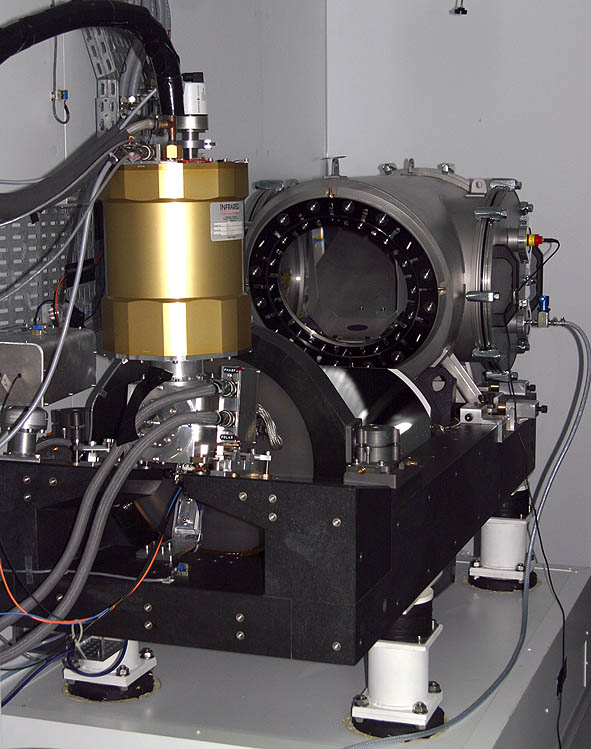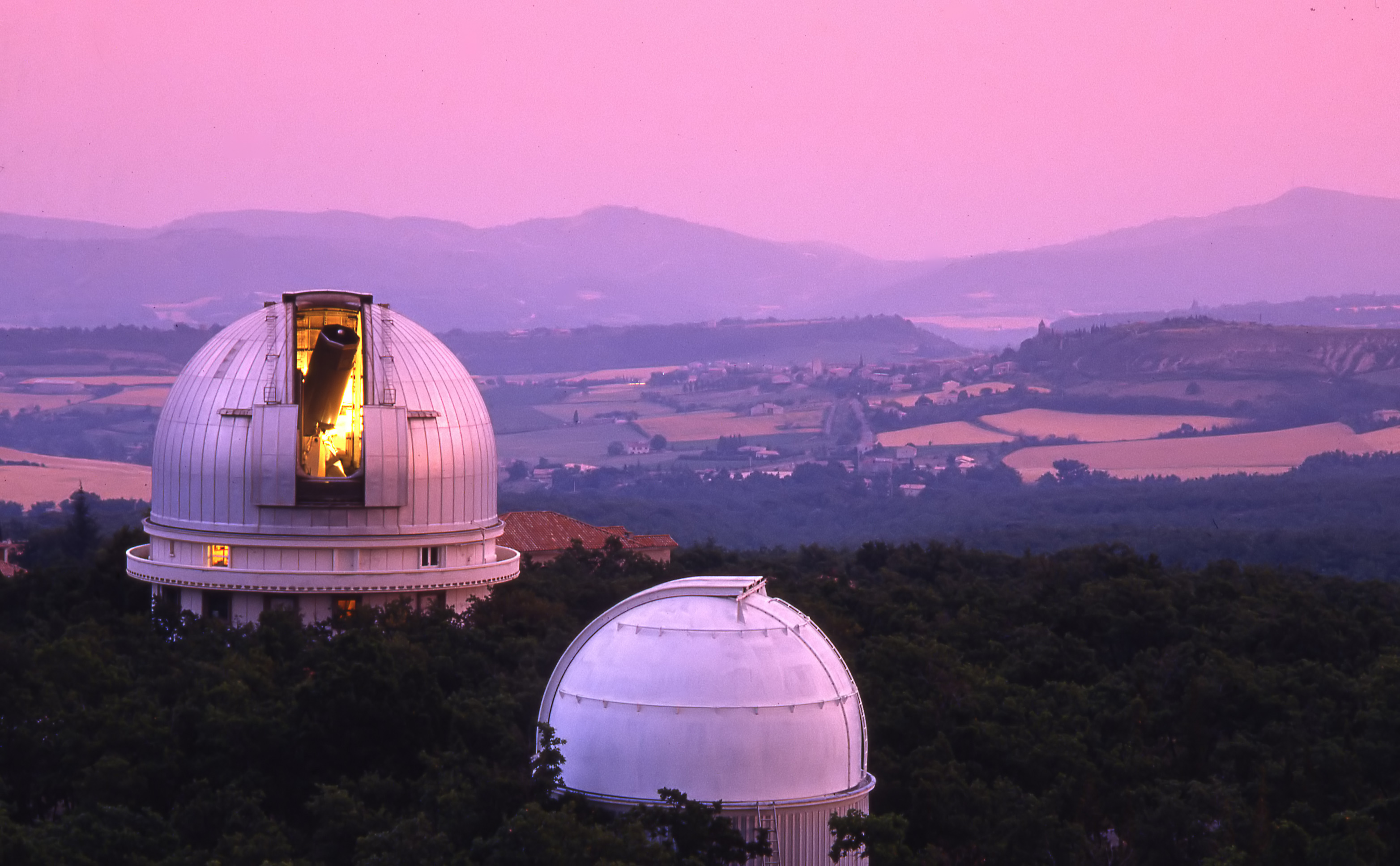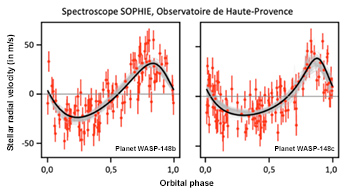DISCOVERY OF AN EXTRASOLAR SYSTEM WITH TWO STRONGLY INTERACTING PLANETS
An international team led by Guillaume Hébrard from the Institut d’astrophysique de Paris detected and characterized a particularly interesting exoplanetary system. It consists of a first planet, WASP-148b, which passes in front of its host star with a period of 8.8 days, and a second one, WASP-148c, whose period is about four times longer. This configuration causes small variations of the WASP-148b period, due to gravitational interactions between both planets. These variations were observed for the first time from the ground for this type of phenomenon. Observations and studies of this system will continue in order to better understand its structure and evolution.
 Figure 1: Artistic view of the exoplanetary system WASP-148 (© Institut d’astrophysique de Paris, Mark A. Garlick). The planet WASP-148c is shown in front. On the back, one can see the planet WASP-148b transiting in front of the host star around which the two planets are in orbit.
Figure 1: Artistic view of the exoplanetary system WASP-148 (© Institut d’astrophysique de Paris, Mark A. Garlick). The planet WASP-148c is shown in front. On the back, one can see the planet WASP-148b transiting in front of the host star around which the two planets are in orbit.
Since the discovery in 1995 of the first exoplanet in orbit around a Solar-type star, planets around stars other than the Sun are the topic of many studies. In this context, the search for systems including several planets orbiting the same star is particularly interesting. Such planets attract each other because of their gravity, and this produces changes in their movement that can be detected in some cases.
When a single exoplanet orbits a star, it turns around it with a well-defined period that does not vary. If the orbit is oriented so that the planet passes just in front of its star, from the Earth, one can observe a small dip in the stellar light during what is called a “planetary transit”. The transits reproduce at regular intervals of time, allowing one to accurately measure the orbital period of the planet ; it can thus be seen that this period does not vary. If the star hosts a second planet in addition to the transiting one, the gravitational interactions between both planets cause small accelerations or decelerations of the planets on their orbits. One observes planetary transits a little in advance or late from one passage to another, a phenomenon called “transit timing variation” (or TTV).
Predicted from a theoretical point of view, transit time variations have long remained unobserved despite numerous searches with ground-based telescopes. Indeed, in most cases gravitational interactions lead to transit timing variations of a few seconds or less, which are difficult to detect. The Kepler space telescope was the first to detect transit timing variations in an exoplanetary system (in 2010). This case was particularly favorable to detection because the two main planets of this system have orbital periods around 38 and 19 days, so one is nearly double of the other one. Thus, both planets are often in configurations that intensify their interaction, which has the effect of increasing the amplitude of transit timing variations; this is called a resonance. Presently, a few dozen resonant planetary systems with transit timing variations have been detected, all with space telescopes.
 Figure 2: SOPHIE spectrograph (© OSU Pytheas, CNRS, AMU). Mounted at the 193-cm telescope of the Observatoire de Haute-Provence and regulated in temperature and pressure, this instrument is dedicated to detecting and characterizing extrasolar planets by accurately measuring the small radial velocity variations that they induce in their host stars.
Figure 2: SOPHIE spectrograph (© OSU Pytheas, CNRS, AMU). Mounted at the 193-cm telescope of the Observatoire de Haute-Provence and regulated in temperature and pressure, this instrument is dedicated to detecting and characterizing extrasolar planets by accurately measuring the small radial velocity variations that they induce in their host stars.
The planetary system WASP-148 (Figure 1), whose discovery is announced on July 2, 2020 by an international team, was detected from ground-based telescopes. A transiting planetary candidate had first been identified by the SuperWASP instrument, installed at the Roque de los Muchachos Observatory in La Palma, Canary Islands. From 2014, the host star was observed with the high-resolution spectroscope SOPHIE (Figure 2) installed at the Observatoire de Haute-Provence (Figure 3), in France. SOPHIE accurately measures the variations in the radial velocity of stars due to the presence of exoplanets. All these observations have led to the conclusion that star WASP-148 hosts a first planet, WASP-148b, having about the size and mass of Saturn and an orbital period of 8.8 days. SOPHIE’s observations also revealed that a second planet is in orbit around this star, WASP-148c, with a mass half that of Jupiter and an orbital period of 34.5 days (Figure 4).
The system is close to resonance, the orbital period of planet WASP-148c being approximately four times longer than that of WASP-148b. Transit timing variations were indeed detected, using small telescopes located in the Canary Islands (Nites, Carlos-Sánchez, and Liverpool telescopes) and in France (Hubert-Reeves amateur observatory, in Ardèche): transits of WASP-148b in front of its star were observed and sometimes occurred a quarter of an hour ahead of or behind the prediction by considering a constant orbital period (Figure 4). We thus have a good understanding of the structure of this planetary system and the interactions that govern it, the transit time variations of planet WASP-148b being explained by the presence of planet WASP-148c. Theoretical studies of gravitational interactions between both planets also indicate that their orbits are approximately coplanar (located in planes with an angle of less than 35 degrees between them), and that this configuration is stable.
This result is the first ground-based detection of transit timing variations for a resonant planetary system, obtained after ten years of observation. In the coming months and years, the WASP-148 multiplanetary system will be the subject of numerous theoretical studies and additional observations: measurement of its properties are expected to be refined, and its structure and evolution better understood. In particular, the system is currently observed by NASA’s Transiting Exoplanet Survey Satellite (TESS) space telescope. Nine consecutive transits of WASP-148b are expected to be observed, and the possible existence of a transit for WASP-148c, which would be due to the passage of this second planet in front of its host star, will be tested.
 Figure 3: Observatoire de Haute-Provence (© OSU Pytheas, CNRS, AMU). The SOPHIE spectroscope is installed at the 193-cm telescope (background), and contributed to the detection and characterization of the exoplanetary system WASP-148.
Figure 3: Observatoire de Haute-Provence (© OSU Pytheas, CNRS, AMU). The SOPHIE spectroscope is installed at the 193-cm telescope (background), and contributed to the detection and characterization of the exoplanetary system WASP-148.
 Figure 4: Radial velocity measurements (in red) of star WASP-148 with the SOPHIE spectroscope at the Observatoire de Haute-Provence (© G. Hébrard et al.). They show the variation of the stellar velocity due to planets WASP-148b (left) and WASP-148c (right). The black lines represent the theoretical model that is best fitting the observations.
Figure 4: Radial velocity measurements (in red) of star WASP-148 with the SOPHIE spectroscope at the Observatoire de Haute-Provence (© G. Hébrard et al.). They show the variation of the stellar velocity due to planets WASP-148b (left) and WASP-148c (right). The black lines represent the theoretical model that is best fitting the observations.
 Figure 5: Example of transits of planet WASP-148b measured by two telescopes on two different nights (© G. Hébrard et al.). Each point indicates the amount of light measured from the star, and the black line represents the theoretical model. A small dip in this light curve is observed when planet WASP-148b passes in front of its star. The precise measurement of the transit center allows one to detect the transit time variations caused by the gravitational effects of planet WASP-148c.
Figure 5: Example of transits of planet WASP-148b measured by two telescopes on two different nights (© G. Hébrard et al.). Each point indicates the amount of light measured from the star, and the black line represents the theoretical model. A small dip in this light curve is observed when planet WASP-148b passes in front of its star. The precise measurement of the transit center allows one to detect the transit time variations caused by the gravitational effects of planet WASP-148c.
Links
![]() Astronomy and Astrophysics’ article: Hébrard et al., 2020, “Discovery and characterization of the exoplanets WASP-148b and c. A transiting system with two interacting giant planet” https://www.aanda.org/articles/aa/pdf/2020/08/aa38296-20.pdf (public version)
Astronomy and Astrophysics’ article: Hébrard et al., 2020, “Discovery and characterization of the exoplanets WASP-148b and c. A transiting system with two interacting giant planet” https://www.aanda.org/articles/aa/pdf/2020/08/aa38296-20.pdf (public version)
![]() CNRS’s press release: “Unprecedented ground-based discovery of two strongly interacting exoplanets”
CNRS’s press release: “Unprecedented ground-based discovery of two strongly interacting exoplanets”
![]() Citizen science operation for the public's contribution to the observation of the transits of WASP-148b, led since 2021 by the Association française d'astronomie (AFA), in collaboration with the IAP.
Citizen science operation for the public's contribution to the observation of the transits of WASP-148b, led since 2021 by the Association française d'astronomie (AFA), in collaboration with the IAP.
Writing and contact
- Guillaume Hébrard
Institut d’Astrophysique de Paris, CNRS, Sorbonne Université
guillaume.hebrard [at] iap [dot] fr
Web writing: Valérie de Lapparent
Layout and iconography: Jean Mouette
July 2020
